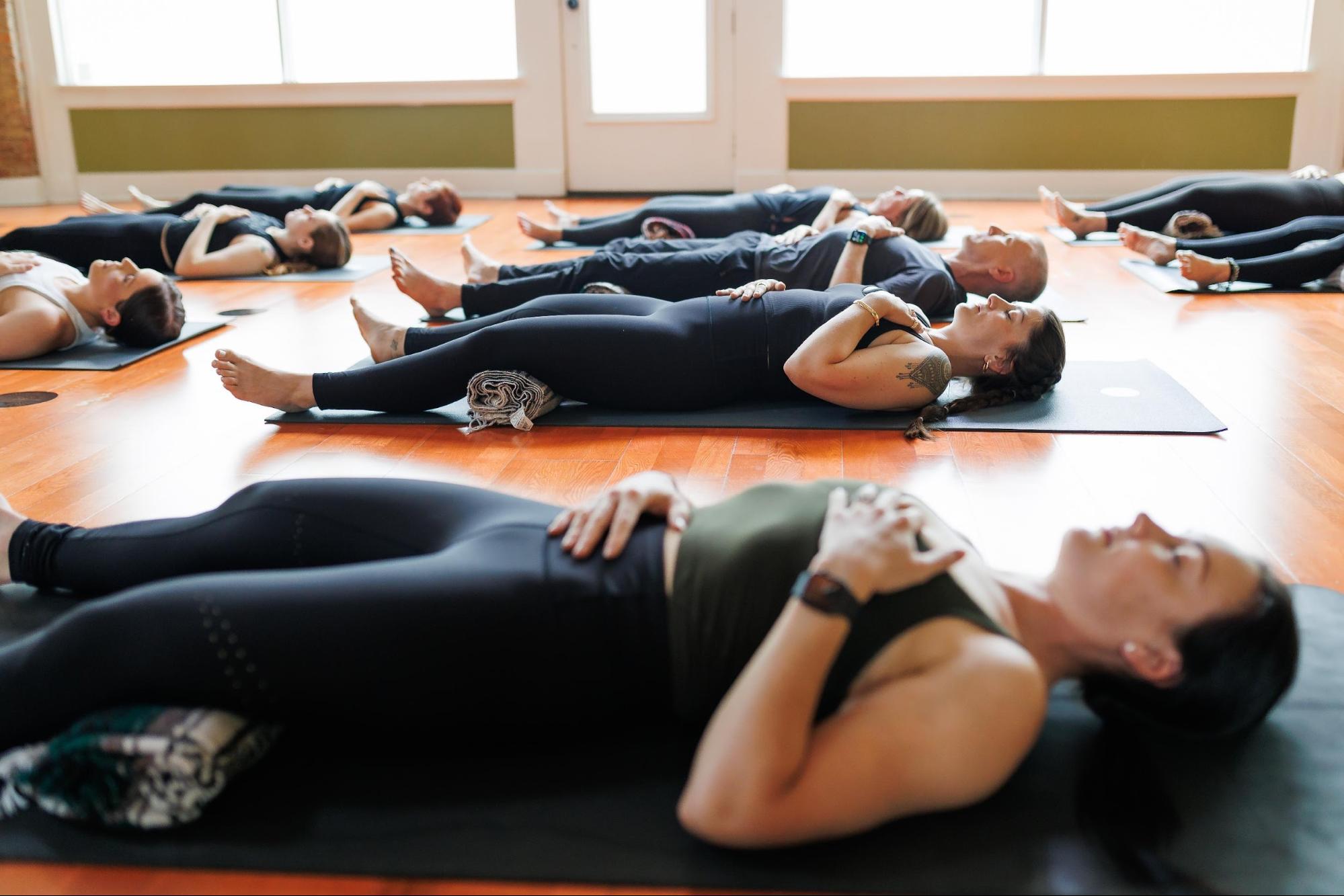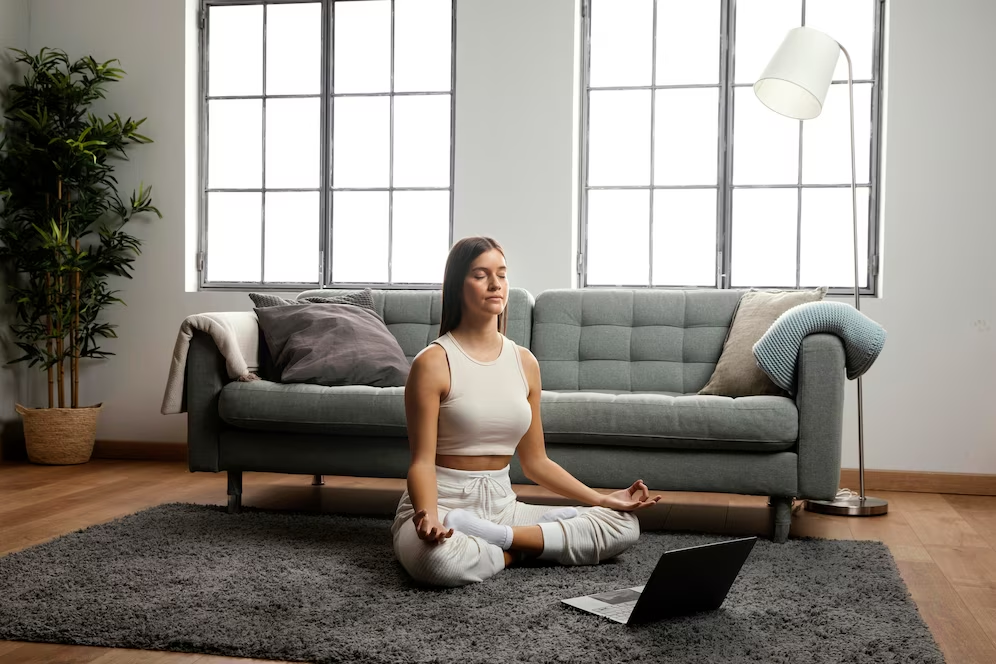
Rediscovering Relaxation With Yoga Nidra
September 6, 2023
How would you like to discover a form of yoga that has the potential to restore your energy like a good night’s sleep but only requires 20 minutes of your time? Or perhaps you’re struggling to relax and ‘switch off’ at the end of an intense day. Yoga Nidra meditation can help with both.
We scratched the surface of this practice in a recent blog post but never went into much detail. With our next Yoga Nidra workshop just a few weeks away, our team felt it was the right time to dive in a little more and explore this ancient practice and its modern-day benefits.
What is Yoga Nidra?

Yoga Nidra is an ancient practice with first mentions stretching back to the third-century Hindu epic Mahabharata. Those early texts don’t describe an actual practice but rather a state of mind and, later on, a goddess by the name of Yoga Nidra. Since the Middle Ages, Yoga Nidra has been linked to meditation, and this link still exists today.
As part of our modern yoga practice, Yoga Nidra is also known as yogic sleep. The name describes a powerful meditation technique that works to both restore and relax the body and mind. Yoga Nidra is also one of the most accessible yoga practices whether you’re a novice, a highly experienced practitioner, or someone who struggles with practicing meditation or yoga.
Plus, this yoga is an excellent way to continue practicing meditation and yoga when you’re recovering from an injury. There are no challenging moves or poses to hold. Last but not least, there is no way of getting yogic sleep wrong.
What Are the Benefits of Yoga Nidra?
Aside from being highly accessible, no matter what your level of yoga experience is, Yoga Nidra has plenty of other benefits across the physical, mental and emotional realms.
Starting with mental and emotional benefits, this yoga is a simple but highly effective way to lower your stress levels even if you only have a few minutes to practice. Research has shown that this practice can also ease the symptoms of mental health conditions like anxiety, depression, and some addictive conditions.
On the physical side, Yoga Nidra reduces muscle tension and can help reduce the symptoms of chronic pain sufferers. The pain may not go away completely, but there is an excellent chance that it becomes more manageable.
Perhaps most importantly, practicing yogic sleep gives you a chance to connect with your body and your mind. Other meditation practices may do the same, but for some practitioners, Yoga Nidra is more accessible.
Why is this connection so important? Most of us have extremely busy lifestyles, balancing work, family, and friends. Going through our day, it can sometimes feel like we’re on autopilot instead of actively living our lives. Spending just a few minutes practicing this yoga allows you to return to the present and actively live your life. The more regularly you can do that, the more your psyche benefits.
How Can You Start Practicing Yoga Nidra?

With such multi-layered, complex benefits, you would be forgiven for assuming that Yoga Nidra is a complex practice. The opposite is the case. Most of the time, you start your Yoga Nidra practice in savasana, or corpse pose.
For beginners, that means simply lying on the floor and trying to relax every single muscle in your body. If lying down is not comfortable for you, you can also perform it seated, but most people find it easier to relax when they’re lying down.
Once you’re comfortable, our experienced instructors will start to guide you as you relax deeper and deeper. All you need to do is follow their voice as it leads you from your toes along your legs and guides you to let go of the tensions of the day and connect deeply to your body.
Not everyone simply relaxes physically during their practice. For some, Yoga Nidra opens the doors to deep emotions they haven’t allowed themselves to experience for a long time. There is no need to become overwhelmed. You can release even long-held emotions during your practice.
What If I Fall Asleep?
Don’t worry, you wouldn’t be the first person to fall asleep during one of this yoga practice session. You will still benefit as your subconscious mind continues to ‘listen’ and absorbs your teacher’s guidance.
Many practitioners report that they reach a state of deep relaxation between waking and sleeping during their practice. To ease your return from Yoga Nidra to the real world, your instructor will ask you to invite gentle movement back into your body, helping you transition from yogic sleep to the rest of your day.
Can I Practice Yoga Nidra At Home?

Absolutely! You can practice Yoga Nidra at home using your favorite yoga app or join Uptown Yoga online classes. In time, you may even find that simply bringing your attention from one body part to another in a sequence. Once you have completed individual body parts, take a deep breath in and draw your awareness to your whole body, allowing it to melt into the floor, letting go of any stressors and tension.
It only takes a few minutes to scan your body like this, but the benefits are long-lasting. Once you spend a few minutes relaxing your entire body, slowly start moving and take your time coming back to a seated position and opening your eyes.
Take the Next Step
Yoga Nidra can be transformative if you allow yourself to integrate the practice into your daily routine. Not sure where to start? Join Uptown Yoga on October 8 for an in-depth Yoga Nidra workshop that gives you all the tools you need to get started. This workshop is the perfect opportunity to experience how healing this practice can be. Don’t miss out – contact us or reserve now to secure your space.




